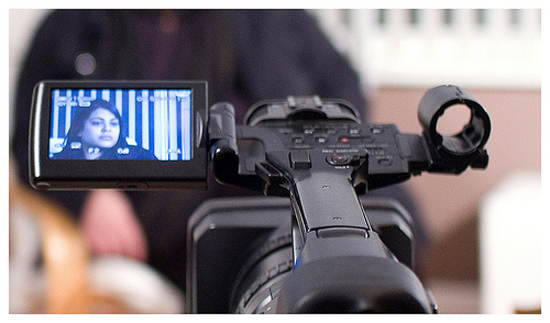
How your nonprofit can capture the best stories on camera
Target audience: Nonprofits, NGOs, cause organizations, social enterprises, brands, educators, video producers, Web publishers, storytellers, individuals.
This is part 2 of a two-part series on video storytelling. Also see part 1:
• How to find amazing, powerful stories for your nonprofit video
By Lindsay Oberst
Socialbrite staff
 Stories are a great tool, which nonprofits too often don’t take advantage of. Whether you’re running a campaign or conveying your organization’s mission by spotlighting the people you help, you should be thinking about how to find stories that move people to action.
Stories are a great tool, which nonprofits too often don’t take advantage of. Whether you’re running a campaign or conveying your organization’s mission by spotlighting the people you help, you should be thinking about how to find stories that move people to action.
Once you uncover those stories, it can be hard to get people to tell them on camera and to get the details needed to make an awesome, powerful story. But by following the suggestions below, you can come away with great visual stories that should resonate with your community. And remember, a photo collage with a voiceover can be just as effective as a traditional video.
The following are tips from people who regularly make videos for social good, including Chris Yates of Huddle Productions, Cara Jones of Storytellers for Good, Tritia Pocci, who has created strategy for marketing media content, and Danielle Bernstein of Clear Films.
1Understand your goal. Think about what you want to accomplish with the video: Enlighten people about a cause? Move them to action? Don’t muddy it up with multiple missions. Have a plan.
2“Research, research, research,” Pocci said. Take the time to be inspired, know your subject and figure out what will work in your video.
— Tritia Pocci
3Keep it really simple. “Start with a simple storyline, get clear about the message you want to communicate and visualize the most concise way to convey this message through an interview beforehand,” Pocci said.
4 Don’t bring notes to the video session. This will help the person on camera feel more at ease and will cut down on distractions. “Subconsciously they’ll think they’re being interviewed and they’ll clam up,” Yates said. So just memorize a few key points that you want to cover. Adds Pocci: “Interviews can take on a life of their own, and sometimes that is where the magic happens.”

5Don’t have the person look directly at the camera if your subject will be sitting down. Place yourself to the left or right and have them look at you. This will help them feel more comfortable as they talk.
6Work with only a two-person crew: a videographer and an interviewer. “I generally start these conversations while the videographer is setting up and just have him or her tap me on the shoulder when the camera is rolling,” Jones said. But remember: You can be your own crew, too, and do a one-on-one interview.
7Use people who want to be on camera. “They are generally the most articulate and comfortable,” Jones said.
8For reluctant storytellers, Jones advises motivating them by providing them with a larger sense of purpose. “They may need to be reminded that by telling their story they can help the nonprofit raise funds or reach out to others in their shoes,” she said.

9Put them at ease — start the interview with a subject they feel comfortable talking about. “Even if it’s totally unrelated to the interview topic, this will help them get used to being on camera,” Jones said.
10Discuss sensitive subjects ahead of time. If you’re dealing with difficult subjects, talk beforehand to the person about what they feel comfortable talking about. “This instills a sense of trust and allows them to be prepared for difficult questions,” Jones said.
11Remind people that you have endless tape. “I always remind people that if they don’t like something they say they can start over again … and again,” Jones said. “If they are getting stuck on something, I find a different way to ask the question to put them more at ease.”
12Shoot some footage of them doing what they love to do. You can shoot them sitting down and talking with you, but you may want to break that up with shots of them doing instead of just talking — say, teaching a workshop, or working in a greenhouse.

13Look for the right chemistry. Sometimes the person with the story is not who you’d expect. Pocci cites the lead singer and lead guitarist from the hair band Poison. One has a sassy, gregarious, carefree personality, the other tends to the pensive, serious side. Which is better suited for your video?
14Spend time with people. Get to know them a bit better before you start in cold on an interview.
15Be confident. Steer the interview in the direction you want it to go. If the discussion meanders, pull it back to achieve what you want to accomplish.
16Show respect for the person telling their story. Be sure to thank them and let them know when it will appear online.
What tips do you have for getting people to tell stories?
Photo credits:
• Image at top by jsawkins
• 2nd Image by newmediaconsortium
• 3rd image by Repoort
• 4th image byDplanet::
Related
• Guide to shooting better online video (Socialbrite)
• 8 tips to help you shoot video like a pro (Socialbrite)
• 4 ways to tell a visual story for your nonprofit (Socialbrite)
• Mash up a visual story for your nonprofit (Socialbrite)
• A quick guide to multimedia software (Socialbrite)
• Complete guide to creating a video project (Socialbrite)
• More resources to help your organization create media (Socialbrite)Lindsay Oberst is a freelance writer who writes about art, culture and topics that relate to social and environmental good. Follow her on Twitter at @LindsayOSocial for social good discussions or at @LindsayOWrite to chat about writing.
 This work is licensed under a Creative Commons Attribution 3.0 Unported.
This work is licensed under a Creative Commons Attribution 3.0 Unported.









waseem roomi
Hi, could you please give me some suggestions on how to improve my videos…here is my latest…the people speaking in Italian are saying how tango changed and improved their lives…we teach tango through ZEN concepts
http://www.youtube.com/watch?v=pZxh4quSyms